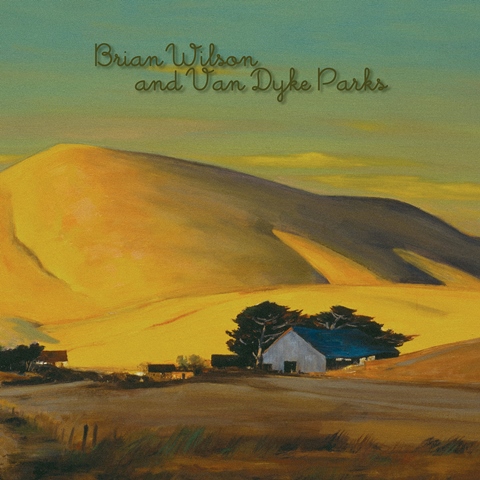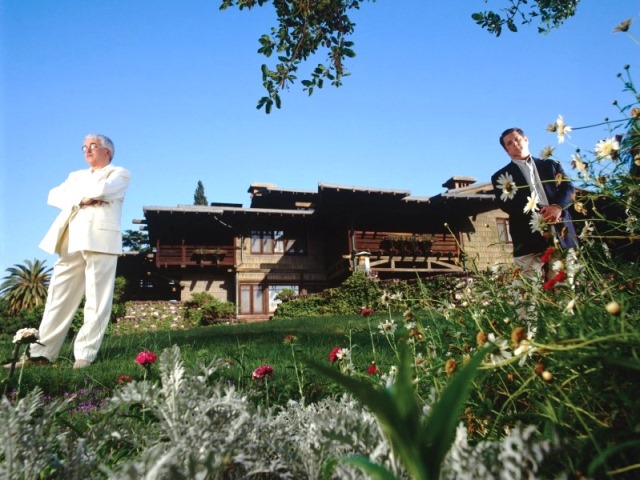Reissue CDs Weekly: Brian Wilson and Van Dyke Parks - Orange Crate Art | reviews, news & interviews
Reissue CDs Weekly: Brian Wilson and Van Dyke Parks - Orange Crate Art
Reissue CDs Weekly: Brian Wilson and Van Dyke Parks - Orange Crate Art
California-inspired collaboration between two American greats sounds better than ever

Orange Crate Art makes most sense in the context of Van Dyke Parks’s solo career rather than that of Brian Wilson’s. For the former it was preceded by Tokyo Rose, an orchestrated set tackling the intersections of American-Japanese cultural and socio-political relations.
Before Song Cycle, when Parks and Wilson undertook their first, uncompleted collaboration for The Beach Boys with SMiLE, the division of labour was clear. Wilson did the music, Parks the lyrics. Their next hook-up, for 1973’s “Sail on Sailor”, was holistic as they came together for the music and words. After this, Orange Crate Art became the next reunion.
 The 25th-anniversay reissue of Orange Crate Art confirms the nature of their third alliance. Parks invited Wilson to sing on an album where the backing tracks were already recorded. Parks wrote and arranged the music. The lyrics were his too. This was more than a reversal of the SMiLE-era roles. Indeed, the pudding-proof comes with Disc Two of the new release, the first-ever airing of the entire album’s Wilson-free instrumental tracks.
The 25th-anniversay reissue of Orange Crate Art confirms the nature of their third alliance. Parks invited Wilson to sing on an album where the backing tracks were already recorded. Parks wrote and arranged the music. The lyrics were his too. This was more than a reversal of the SMiLE-era roles. Indeed, the pudding-proof comes with Disc Two of the new release, the first-ever airing of the entire album’s Wilson-free instrumental tracks.
When Orange Crate Art was released in November 1995 by Parks’s long-time label Warner Brothers, Wilson had recently issued his second solo album, August’s patchy documentary tie-in I Just Wasn't Made For These Times. Almost ten years later, Wilson and Parks went on to revisit SMiLE and, ultimately, Orange Crate Art must have fed into the process of looking back to what was abandoned in the Sixties.
All of which makes Orange Crate Art integral to an ever-cycling continuum.
Hearing the album 25 years after it first came out brings home how much it is in the grand tradition of the baroque, boundary pushing albums Warner Brothers was releasing since around 1967: Parks’s own Song Cycle, The Neon Philharmonic’s The Moth Confesses, The Beau Brummels’s Triangle, Harpers Bizarre 4 – many more. Sadly, Orange Crate Art instantly became the last gasp of the long-running vision of what Warner could be. The album’s executive producer Lenny Waronker left the label in 1995, as did other Warner’s veterans during a culling made without regard to what made the label what it was. For the new masters, corporate jockeying took precedence over fostering creativity,
 It’s a strange album, and not immediate. The vocal melodies are direct but framed by curlicued orchestration incorporating baroque flurries of accordion, percussion, twinkling bells and multi-tracked voices. Disparate musical styles are co-opted: ragtime, smooth small-combo vocal groups, sweeping soundtrack-style orchestrations, vaudeville oom-pah. Despite the thematic scenario, this isn’t musical reportage but instead builds on the California signifiers – a palm tree, say – and works them into wordy song-stories examining what lies under latter-day veneers. Nostalgia refracted as art-music.
It’s a strange album, and not immediate. The vocal melodies are direct but framed by curlicued orchestration incorporating baroque flurries of accordion, percussion, twinkling bells and multi-tracked voices. Disparate musical styles are co-opted: ragtime, smooth small-combo vocal groups, sweeping soundtrack-style orchestrations, vaudeville oom-pah. Despite the thematic scenario, this isn’t musical reportage but instead builds on the California signifiers – a palm tree, say – and works them into wordy song-stories examining what lies under latter-day veneers. Nostalgia refracted as art-music.
Orange Crate Art is expanded to a 2-CD set by the inclusion of the instrumental tracks on the second disc. Disc One includes three previously unheard album offcuts: a lush, lovely wordless-vocal infused version of "Rhapsody in Blue", a creaky "What a Wonderful World" and "Love is Here to Stay”, a Fifties-edged performance with a Perry Botkin arrangement written in tribute to Warner’s soon-to-be-ejected top-brass. The lyrics are not included in the booklet. It would have been nice if they were.
After Orange Crate Art, Brian Wilson issued another solo album, 1998’s OK Imagination, and then embarked on his Pet Sounds live shows. There was also the awful Beach Boys album Stars and Stripes Vol. 1. The Parks-Wilson SMiLE emerged in 2004. Bearing in mind his disjointed and too-frequently unsatisfactory subsequent path, Brian Wilson perhaps ought to have continued working with Van Dyke Parks immediately after Orange Crate Art to build on what had been created in 1995.
- Next Week: The independent British popsters Razorcuts and their Storyteller and The World Keeps Turning albums
- More reissue reviews on theartsdesk
- Kieron Tyler’s website
Explore topics
Share this article
The future of Arts Journalism
You can stop theartsdesk.com closing!
We urgently need financing to survive. Our fundraising drive has thus far raised £49,000 but we need to reach £100,000 or we will be forced to close. Please contribute here: https://gofund.me/c3f6033d
And if you can forward this information to anyone who might assist, we’d be grateful.

Subscribe to theartsdesk.com
Thank you for continuing to read our work on theartsdesk.com. For unlimited access to every article in its entirety, including our archive of more than 15,000 pieces, we're asking for £5 per month or £40 per year. We feel it's a very good deal, and hope you do too.
To take a subscription now simply click here.
And if you're looking for that extra gift for a friend or family member, why not treat them to a theartsdesk.com gift subscription?
more New music
 Moroccan Gnawa comes to Manhattan with 'Saha Gnawa'
Trance and tradition meet Afrofuturism in Manhattan
Moroccan Gnawa comes to Manhattan with 'Saha Gnawa'
Trance and tradition meet Afrofuturism in Manhattan
 Soulwax’s 'All Systems Are Lying' lays down some tasty yet gritty electro-pop
Belgian dancefloor veterans return to the fray with a dark, pop-orientated sound
Soulwax’s 'All Systems Are Lying' lays down some tasty yet gritty electro-pop
Belgian dancefloor veterans return to the fray with a dark, pop-orientated sound
 Music Reissues Weekly: Marc and the Mambas - Three Black Nights Of Little Black Bites
When Marc Almond took time out from Soft Cell
Music Reissues Weekly: Marc and the Mambas - Three Black Nights Of Little Black Bites
When Marc Almond took time out from Soft Cell
 Album: Mobb Deep - Infinite
A solid tribute to a legendary history
Album: Mobb Deep - Infinite
A solid tribute to a legendary history
 Album: Boz Scaggs - Detour
Smooth and soulful standards from an old pro
Album: Boz Scaggs - Detour
Smooth and soulful standards from an old pro
 Emily A. Sprague realises a Japanese dream on 'Cloud Time'
A set of live improvisations that drift in and out of real beauty
Emily A. Sprague realises a Japanese dream on 'Cloud Time'
A set of live improvisations that drift in and out of real beauty
 Trio Da Kali, Milton Court review - Mali masters make the ancient new
Three supreme musicians from Bamako in transcendent mood
Trio Da Kali, Milton Court review - Mali masters make the ancient new
Three supreme musicians from Bamako in transcendent mood
 Hollie Cook's 'Shy Girl' isn't heavyweight but has a summery reggae lilt
Tropical-tinted downtempo pop that's likeable if uneventful
Hollie Cook's 'Shy Girl' isn't heavyweight but has a summery reggae lilt
Tropical-tinted downtempo pop that's likeable if uneventful
 Pop Will Eat Itself's 'Delete Everything' is noisy but patchy
Despite unlovely production, the Eighties/Nineties unit retain rowdy ebullience
Pop Will Eat Itself's 'Delete Everything' is noisy but patchy
Despite unlovely production, the Eighties/Nineties unit retain rowdy ebullience
 Music Reissues Weekly: The Earlies - These Were The Earlies
Lancashire and Texas unite to fashion a 2004 landmark of modern psychedelia
Music Reissues Weekly: The Earlies - These Were The Earlies
Lancashire and Texas unite to fashion a 2004 landmark of modern psychedelia
 Odd times and clunking lines in 'The Life of a Showgirl' for Taylor Swift
A record this weird should be more interesting, surely
Odd times and clunking lines in 'The Life of a Showgirl' for Taylor Swift
A record this weird should be more interesting, surely

Add comment